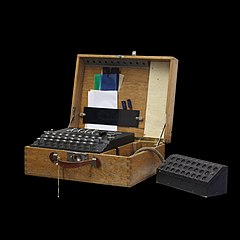
Enigma machine
The Enigma machine is a cipher device developed and used in the early- to mid-20th century to protect commercial, diplomatic, and military communication. It was employed extensively by Nazi Germany during World War II, in all branches of the German military. The Enigma machine was considered so secure that it was used to encipher the most top-secret messages.[1]
This article is about the Enigma machine itself. For the Allied cracking of the machine, see Cryptanalysis of the Enigma.
The Enigma has an electromechanical rotor mechanism that scrambles the 26 letters of the alphabet. In typical use, one person enters text on the Enigma's keyboard and another person writes down which of the 26 lights above the keyboard illuminated at each key press. If plain text is entered, the illuminated letters are the ciphertext. Entering ciphertext transforms it back into readable plaintext. The rotor mechanism changes the electrical connections between the keys and the lights with each keypress.
The security of the system depends on machine settings that were generally changed daily, based on secret key lists distributed in advance, and on other settings that were changed for each message. The receiving station would have to know and use the exact settings employed by the transmitting station to successfully decrypt a message.
Although Nazi Germany introduced a series of improvements to the Enigma over the years that hampered decryption efforts, they did not prevent Poland from cracking the machine as early as December 1932 and reading messages prior to and into the war. Poland's sharing of their achievements enabled the Allies to exploit Enigma-enciphered messages as a major source of intelligence.[2] Many commentators say the flow of Ultra communications intelligence from the decrypting of Enigma, Lorenz, and other ciphers shortened the war substantially and may even have altered its outcome.[3]
The Enigma was influential in the field of cipher machine design, spinning off other rotor machines. Once the British discovered Enigma's principle of operation, they created the Typex rotor cipher, which the Germans believed to be unsolvable.[79] Typex was originally derived from the Enigma patents;[80] Typex even includes features from the patent descriptions that were omitted from the actual Enigma machine. The British paid no royalties for the use of the patents.[80] In the United States, cryptologist William Friedman designed the M-325 machine,[81] starting in 1936,[82] that is logically similar.[83]
Machines like the SIGABA, NEMA, Typex, and so forth, are not considered to be Enigma derivatives as their internal ciphering functions are not mathematically identical to the Enigma transform.
A unique rotor machine called Cryptograph was constructed in 2002 by Netherlands-based Tatjana van Vark. This device makes use of 40-point rotors, allowing letters, numbers and some punctuation to be used; each rotor contains 509 parts.[84]








